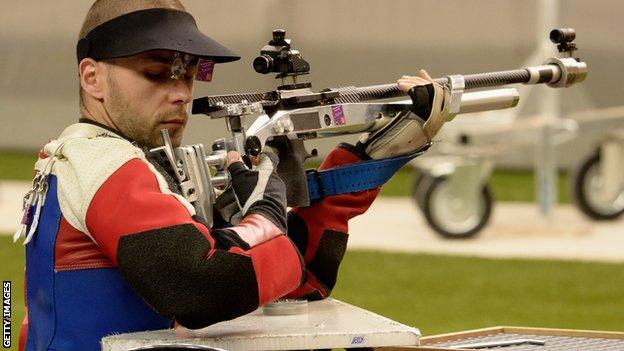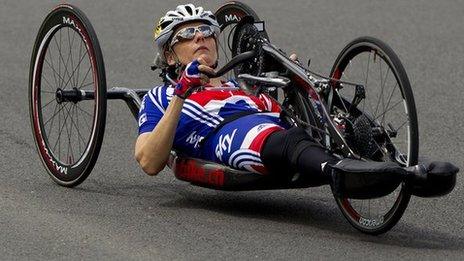Shooting at the Rio 2016 Paralympics: All you need to know
- Published
Paralympic Games on the BBC |
|---|
Venue: Rio de Janeiro, Brazil Dates: 7-18 September Time in Rio: BST -4 |
Coverage: Follow on Radio 5 live and via live text commentary. |

Matt Skelhon is a gold medallist in the 10m air rifle event from the Beijing 2008 Paralympics - he won bronze at London 2012 in the 50m event
How does it work?
Shooting events at the Paralympics are held in both pistol and rifle.
Of the 12 Paralympic shooting events, six are mixed while there are three competitions for men and a further three for women.
Air pistol is shot over 10m and .22 calibre weapons over 50m while there is also a 25m pistol event.
In rifle, there are 10m events in both standing and prone positions plus prone and 3-position events (standing, prone and kneeling) over 50m.
In qualification, each competitor takes a specified number of shots at the target in a set time period - 40 shots in women's air pistol and rifle, 120 in men's three position and 60 in the remaining events.
The target consists of 10 concentric scoring rings, with the central ring worth 10 points and the outside ring worth one.
Targets vary in size depending on the event. In the 10m air rifle event the whole target is 4.5cm in diameter and the central ring is just half a millimetre across.
After London 2012 the qualification system in most rifle events changed to one decimal point as many competitors were scoring the maximum 600. The top score for a shot is now 10.9
After the qualification round the eight top scoring athletes go through to a 20 shot final where all scores are reset to zero. The shots in the final are scored to one decimal place, with a top score of 10.9.
After the first eight shots, and every two shots thereafter, the lowest place shooter is eliminated until only two remain for the final two shots.
Shooting uses a classification system which enables athletes from different impairment groups with the same level of functional ability to compete together.
SH1 pistol and rifle competitors do not require a shooting stand while SH2 rifle competitors are not able to support the weight of the firearm with their arms and require a spring-mounted stand to shoot.
Who are the British medal hopes?
Matt Skelhon has shaved off the red mohican he sported on his way to winning gold in Beijing in 2008. Four years ago he claimed silver and bronze in the air rifle prone events and will be aiming for more medals this time.
Fellow rifle shooters James Bevis and Ryan Cockbill will also be among those bidding for success along with pistol shooter Stewart Nangle who was fifth for England at the Glasgow Commonwealth Games but will be making his Paralympic debut in Rio.
Who are the other challengers?
More countries are entering the IPC World Cup events and the medals are being shared out more. China are perennial medal winners along with Korea and both will hope to be on the podium again.
Did you know?
Sweden's Jonas Jacobsson has 17 gold medals to his name and will be bidding for more in Rio. He made his debut in 1980 and this will be his ninth Games.
However, in terms of Games appearances, he is still behind Australian shooter Libby Kosmala, who will be representing her country at a 13th Games in Rio at the age of 74.
ParalympicsGB London 2012 medals
Three (one silver, two bronze).
- Published23 August 2016

- Published5 September 2016
